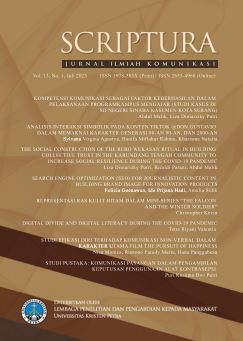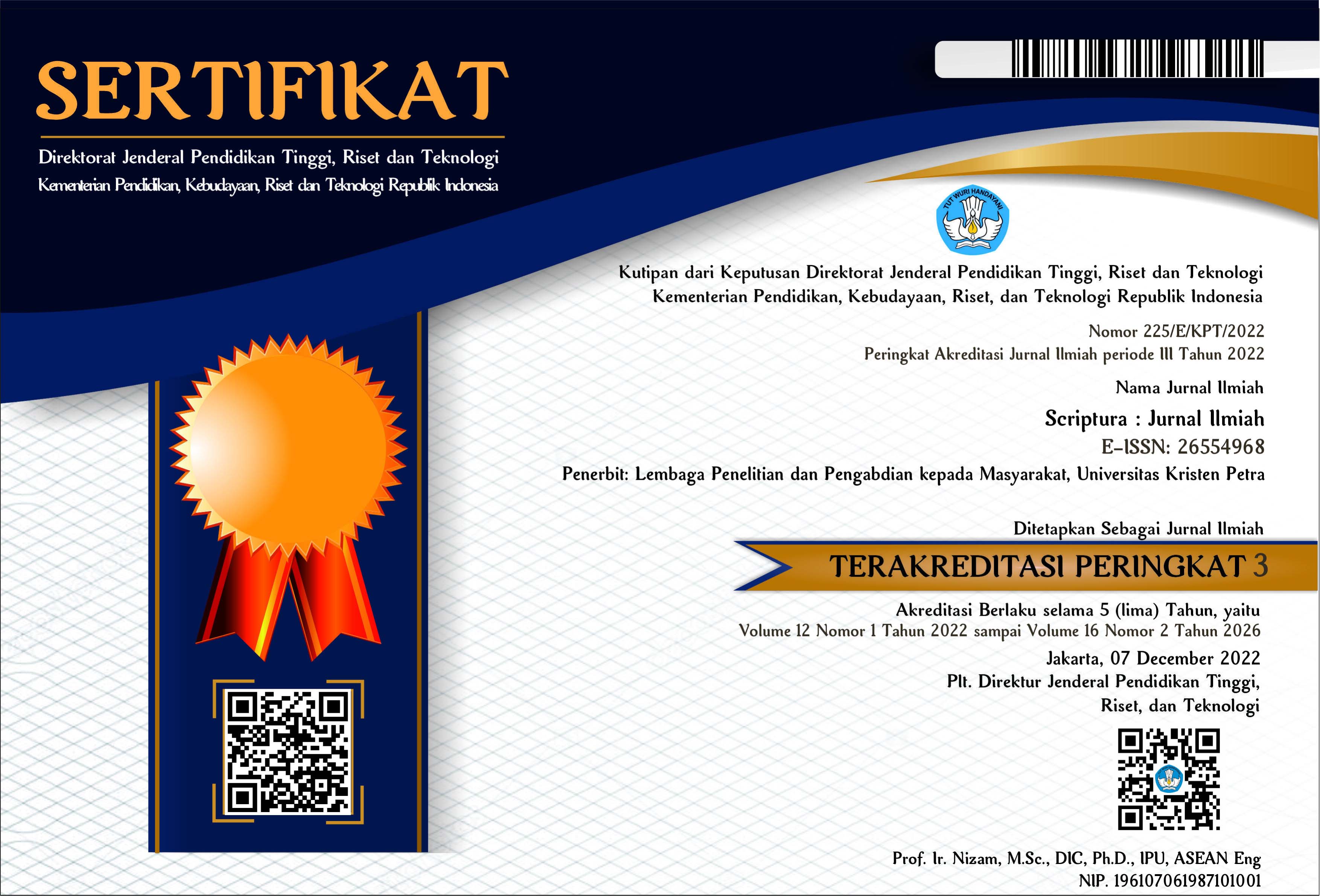Studi Pustaka: Komunikasi Pasangan dalam Pengambilan Keputusan Penggunaan Alat Kontrasepsi
DOI:
https://doi.org/10.9744/scriptura.13.1.90-99Keywords:
Komunikasi antarpasangan, pengambilan keputusan, penggunaan alat kontrasepsi, Keluarga BerencanaAbstract
Secara global angka unmet need pada program Keluarga Berencana (KB) masih belum tercapai. Keterlibatan laki-laki pada penggunaan alat kontrasepsi juga masih rendah. Selama ini program KB masih ditujukan pada perempuan, hal ini membuat KB menjadi bias gender. Program Kependudukan, KB dan Pembangunan Keluarga tertuang pada indikator SDGs 2030 (United Nations) yaitu untuk menjamin kehidupan yang sehat dan mencapai kesetaraan gender serta memberdayakan kaum perempuan. Penelitian ini bertujuan untuk menggambarkan state of the art penelitian komunikasi antar pasangan dalam pengambilan keputusan penggunaan alat kontrasepsi dan meningkatkan komunikasi suami isteri dalam pengambilan keputusan penggunaan alat kontrasepsi. Penelitian ini menggunakan pendekatan review sistematis (systematic review). Hasil penelitian menunjukkan bahwa komunikasi antarpasangan dalam pengambilan keputusan penting dalam kesuksesan program KB terbagi menjadi tipe keputusan; relasi gender; sumber informasi; media; dan Komunikasi, Informasi, dan Edukasi (KIE). Peran keluarga merupakan tahap awal suami/isteri dapat mendiskusikan kapan akan mempunyai anak, berapa jumlah anak yang akan dimiliki, dan penggunaan alat kontrasepsi yang cocok bagi keduanya.
References
Abose, A., Adhena, G., & Dessie, Y. (2021). Assessment of Male Involvement in Long-Acting and Permanent Contraceptive Use of Their Partner in West Badewacho, Southern Ethiopia. Open access journal of contraception, 12, 63–72. https://doi.org/10.2147/OAJC.S297267.
Adelekan, A.L., Omoregie, P., & Edoni, E.R. (2014). Male Involvement in Family Planning: Challenges and Way Forward. International journal of population research, 2014, 1-9. http://dx.doi.org/10.1155/2014/416457
Adelekan, A.L., Omoregie, P., & Edoni, E.R. (2014). Male Involvement in Family Planning: Challenges and Way Forward. International journal of population research, 2014, 1-9. http://dx.doi.org/10.1155/2014/416457
Ajaero, C.K., Odimegwu, C.O., Ajaero, I.D., & Nwachukwu, C.A. (2016). Access to mass media messages, and use of family planning in Nigeria: a spatio-demographic analysis from the 2013 DHS. BMC Public Health, 16(427):1-10. https://doi.org/10.1186/s12889-016-2979-z
Anbesu, E. W., Aychiluhm, S. B., & Kahsay, Z. H. (2022). Male involvement in family planning use and its determinants in Ethiopia: a systematic review and meta-analysis protocol. Systematic reviews, 11(1). https://doi.org/10.1186/ s13643-022-01891-x.
Ankomah A, Anyanti J, Oladosu. Myths, misinformation, and communication about family planning and contraceptive use in Nigeria. Open Access J Contracept. (2011). 2:95-105. https://doi.org/10.2147/OAJC.S20921
Azmat, S.K., Mustafa, G., Hameed, W., Ali, M., Ahmed, A., & Bilgrami, M. (2012). Barriers and perceptions regarding different contraceptives and family planning practices amongst men and women of reproductive age in rural Pakistan: A qualitative study. Pakistan Journal of Public Health, 2, 17-23. https://doi.org/10.1016/s0020-7292(09)61283-2 .
Badan Kependudukan dan Keluarga Berencana Nasional. (2014). Buku Pegangan Bagi Konsultan KUA dan BP4 Tentang Peningkatan Partisipasi. Badan Kependudukan dan Keluarga Berencana Nasional
Badan Kependudukan dan Keluarga Berencana Nasional. (2017). Bahan Penyuluhan Bina Keluarga Balita dan Anak. Penanaman dan Penerapan Karakter Melalui Delapan Fungsi Keluarga. Sebagai Pegangan Kader BKB dan Orang Tua. Jakarta: Direktorat Bina Keluarga dan Anak
Berhane, A., Biadgilign, S., Amberbir, A., Morankar, S., Berhane, A., & Deribe, K. (2011). Men's knowledge and spousal communication about modern family planning methods in Ethiopia. African journal of reproductive health, 15(4), 24–32.
Blumenthal, P. D., Voedisch, A., & Gemzell-Danielsson, K. (2011). Strategies to prevent unintended pregnancy: increasing use of long-acting reversible contraception. Human reproduction update, 17(1), 121–137. https://doi.org/ 10.1093/humupd/dmq026
Bogale, B., Wondafrash, M., Tilahun, T., & Girma, E. (2011). Married women's decision making power on modern contraceptive use in urban and rural southern Ethiopia. BMC public health, 11, 342. https://doi.org/10.1186/1471-2458-11-342
Colle, R. D. (2008). Threads of Development Communication. In Jan Servaes (Ed), Communication for Development and Social Change. UNESCO.
Farmer, D. B., Berman, L., Ryan, G., Habumugisha, L., Basinga, P., Nutt, C., Kamali, F., Ngizwenayo, E., St Fleur, J., Niyigena, P., Ngabo, F., Farmer, P. E., & Rich, M. L. (2015). Motivations and Constraints to Family Planning: A Qualitative Study in Rwanda's Southern Kayonza District. Global health, science and practice, 3(2), 242–254. https://doi.org/10.9745/GHSP-D-14-00198
Habibov, N., & Zainiddinov, H. (2017). Effect of TV and radio family planning messages on the probability of modern contraception utilization in post-Soviet Central Asia. The International journal of health planning and management, 32(1), 17–38. https://doi.org/10.1002/hpm.2318
Hartmann, M., Gilles, K., Shattuck, D., Kerner, B., & Guest, G. (2012). Changes in couples' communication as a result of a male-involvement family planning intervention. Journal of health communication, 17(7), 802–819. https://doi.org/10.1080/10810730.2011.650825
Ibrahim, M., Sabitu, K., Bashir, S., & Olorukooba, A. (2018). Spousal communication on family planning, pregnancy, and delivery care among men in rural Northern Nigeria. Sahel Medical Journal, 21(2), 88-92. https://doi.org/10.4103/smj.smj_66_16.
Ijadunola, M.Y., Abiona, T.C., Ijadunola, K.T., Afolabi, O.T., Esimai, O.A., OlaOlorun, F.M. (2010). Male Involvement in Family Planning Decision Making in Ile-Ife, Osun State, Nigeria. African Journal of Reproduction Health. 14(4): 45-52.
Indriyanti, I.S.2011. Sumber Informasi Yang Mempengaruhi Keputusan Menjadi Akseptor KB Wanita Di Kelurahan Bandarharjo Semarang. Journal Berita Ilmu Kedokteran. Diakses 9 Juli 2013.http://journal.undip.ac.id//
International Planned Parenthood Federation (2011). Male involvement in family planning utilization.In
Irawaty, D., Yasin, S., & Pratomo, H. (2020). Family Planning Communication between Wives and Husbands: Insights from the 2017 Indonesia Demographic and Health Survey. Kesmas: Jurnal Kesehatan Masyarakat Nasional (National Public Health Journal), 15(3), 147-153. http://dx.doi.org/10.21109/kesmas.v15i3.3301
John, N.A. (2013). Couple Relationship and Contraceptive Use in Peri-Urban Ethiopia [Doctoral dissertation, Johns Hopkins University]
Kantorová V, Wheldon MC, Ueffing P, Dasgupta ANZ (2020) Estimating progress towards meeting women’s contraceptive needs in 185 countries: A Bayesian hierarchical modelling study. PLOS Medicine 17 (2):1-23. https://doi.org/10.1371/journal.pmed.1003026
Kohan, S., Simbar, M., & Taleghani, F. (2012). Empowerment in family planning as viewed by Iranian women: a qualitative study. Journal of biosocial science, 44(2), 209–219. https://doi.org/10.1017/S0021932011000563
Kusnadi D, Sutarjo M, Nuruzzaman. 2013. Strategi Komunikasi Antarpribadi Pada Penyebaran Informasi Keluarga Berencana oleh Petugas Penyuluh Keluarga Berencana di Kecamatan Talun Cirebon. Jurnal Signal. Vol 1(2):1-14
Mahmudah, L.T.N., Indrawati, F. (2015). Analisis Faktor yang Berhubungan dengan Pemilihan Metode Kontrasepsi Jangka Panjang (MKJP) Pada Akseptor KB Wanita di Kecamatan Banyubiru Kabupaten Semarang. 4(3):76-85. Unnes Journal of Public Health. https://doi.org/10.15294/ujph.v4i3.7222
Matsuda, Y. (2012). Predictors of Sexual Relationship Power, Communication and Sexual Decision Making among Latino Couples [Doctoral dissertation Virginia Commonwealth University] VCU Scholar Compass. https://doi.org/10.25772/E9TP-5678
Mosha, I., Ruben, R., & Kakoko, D. (2013). Family planning decisions, perceptions and gender dynamics among couples in Mwanza, Tanzania: a qualitative study. BMC Public Health, 13(1). doi:10.1186/1471-2458-13-523
Muanda, M., Gahungu Ndongo, P., Taub, L. D., & Bertrand, J. T. (2016). Barriers to Modern Contraceptive Use in Kinshasa, DRC. PLOS ONE, 11(12), e0167560. doi:10.1371/journal.pone.0167560
Musafaah, M. (2012). Keikutsertaan Pria dalam Program Keluarga Berencana di Indonesia. Kesmas: Jurnal Kesehatan Masyarakat Nasional (National Public Health Journal), 7(4), 158-161. doi:http://dx.doi.org/10.21109/kesmas. v7i4.49
Nmadu, A., Joshua, I., Omole, V., Usman, N., Igboanusi, C.-C., & Gobir, A. (2019). Male involvement in family planning in Northern Nigeria: A review of literature. Journal of Medicine in the Tropics, 21(1), 6-9. https://doi.org/10.4103/ jomt.jomt_29_18.
Ogunjuyigbe, P. O., Ojofeitimi, E. O., & Liasu, A. (2009). Spousal communication, changes in partner attitude, and contraceptive use among the yorubas of southwest Nigeria. Indian journal of community medicine: official publication of Indian Association of Preventive & Social Medicine, 34(2), 112–116. https://doi.org/10.4103/0970-0218.51232
Orji, E. O., Ojofeitimi, E. O., & Olanrewaju, B. A. (2007). The role of men in family planning decision-making in rural and urban Nigeria. The European journal of contraception & reproductive health care : the official journal of the European Society of Contraception, 12(1), 70–75. https://doi.org/10.1080
Paek, H.-J., Lee, B., Salmon, C. T., & Witte, K. (2008). The Contextual Effects of Gender Norms, Communication, and Social Capital on Family Planning Behaviors in Uganda: A Multilevel Approach. Health Education & Behavior, 35(4), 461–477. https://doi.org/10.1177/1090198106296769
Palamuleni, M.E., 2013. Socio-Economic and Demographic Factors Affecting Contraceptive use in Malawi. African of Journal Reproduction Health. 13(3):91-104. https://doi.org/doi:10.4314/ajrh.v17i3
Perloff, R.M. (2017). The Dynamics of Persuasion Communication dan Attitude in The 21st Century. Routledge
Putri, P. K. D. (2012). Pengaruh Tingkat Pendidikan, Pengetahuan, Sikap dan Terpaan Iklan Layanan Masyarakat KB Versi Shireen Sungkar dan Teuku Wisnu di TV terhadap Perilaku KB pada Wanita atau Pria dalam Usia Subur. Interaksi: Jurnal Ilmu Komunikasi, 1(1), 46-56. https://doi.org/10.14710/interaksi.1.1.46-56
Putri, P. K. D. (2021). Perempuan dan Media. In Putri Wahyuni, Ade Irma, & Syamsul Arifin (Eds.), Bagaimana Pemberitaan Media Massa Mengenai Keluarga Berencana (KB) Pria? Syiah Kuala University Press
Putri, P.K.D. (2019). Komunikasi Persuasif Keluarga dalam Pengambilan Keputusan Penggunaan Alat Kontrasepsi [Doctoral dissertation, IPB University]
Rahimah. (2012). Metode Ceramah Dan Media Leaflet Terhadap Pengambilan Keputusan Pus Dalam Memilih Alat Kontrasepsi Di Wilayah Kerja Puskesmas Langsa Lama Kota Langsa. [Master Thesis, Universitas Sumatera Utara]
Rasa Kasih Sayang Kepada Istri, Dorong Pria untuk Ber-KB. (2023, May 8). ttps://keluargaindonesia.id/2023/05/08/rasa-kasih-sayang-kepada-istri-dorong-pria-untuk-ber-kb/#. https://keluargaindonesia.id/2023/05/08/rasa-kasih-sayang-kepada-istri-dorong-pria-untuk-ber-kb/#
Sable, M. R., Havig, K., Schwartz, L. R., & Shaw, A. (2009). Hispanic Immigrant Women Talk About Family Planning. Affilia, 24(2), 137–151. https://doi.org/10.1177/0886109909331693
Shattuck, D., Kerner, B., Gilles, K., Hartmann, M., Ng'ombe, T., & Guest, G. (2011). Encouraging contraceptive uptake by motivating men to communicate about family planning: the Malawi Male Motivator project. American journal of public health, 101(6), 1089–1095. https://doi.org/10.2105/AJPH.2010.300091
Sileo, K. M., Wanyenze, R. K., Lule, H., & Kiene, S. M. (2015). Determinants of family planning service uptake and use of contraceptives among postpartum women in rural Uganda. International journal of public health, 60(8), 987–997. https://doi.org/10.1007/s00038-015-0683-x
Thompson TL., Dorsey A, & Miller KI. (2003). Handbook of Health Communication. Mahwah Lawrence Erlbaum Associates
Tilahun, T., Coene, G., Temmerman, M., & Degomme, O. (2015). Couple based family planning education: changes in male involvement and contraceptive use among married couples in Jimma Zone, Ethiopia. BMC Public Health, 15(1). https://doi.org/10.1186/s12889-015-2057-y
Turner, L.H., West, R. (2013). Perspective on Family Communication. McGrawHill
United Nations, Department of Economic and Social Affairs, Population Division. Family Planning and the 2030 Agenda for Sustainable Development. New York: United Nations. https://www.un.org/en/development/desa/population/publications/pdf/family/familyPlanning_DataBooklet_2019.pdf
Vouking, M. Z., Evina, C. D., & Tadenfok, C. N. (2014). Male involvement in family planning decision making in sub-Saharan Africa- what the evidence suggests. The Pan African medical journal, 19, 349. https://doi.org/10.11604/ pamj.2014.19.349.5090
Walcott, M. M., Ehiri, J., Kempf, M. C., Funkhouser, E., Bakhoya, M., Aung, M., Zhang, K., & Jolly, P. E. (2015). Gender Norms and Family Planning Practices Among Men in Western Jamaica. American Journal of Men’s Health, 307–316. https://doi.org/10.1177/1557988314543792
White, D., & Stephenson, R. (2014). Using Community Mapping to Understand Family Planning Behavior. Field Methods, 26(4), 406–420. https://doi.org/10.1177/1525822X14529256
Winner, B., Peipert, J. F., Zhao, Q., Buckel, C., Madden, T., Allsworth, J. E., & Secura, G. M. (2012). Effectiveness of long-acting reversible contraception. The New England journal of medicine, 366(21), 1998–2007. https://doi.org/10.1056/NEJMoa1110855
Withers, M., Dworkin, S.L., Zakaras, J.M., Onono, M.A., Oyier, B., Cohen, C.R., Bukusi, E.A., Grossman, D., & Newmann, S.J. (2015). ‘Women now wear trousers’: men's perceptions of family planning in the context of changing gender relations in western Kenya. Culture, Health & Sexuality, 17, 1132 - 1146. https://doi.org/10.1080/13691058.2015.1043144
Wowiling, G.J., Pantow, J., Waleleng, G. (2015). Komunikasi Informasi dan Edukasi (KIE) Sebagai Bentuk Sosialisasi Program Keluarga Berencana (KB) di Kelurahan Tingkulu Kecamatan Wanea Manado. Journal Acta Diurna 4(1)
Wright, R. L., Fawson, P. R., Frost, C. J., & Turok, D. K. (2017). U.S. Men’s Perceptions and Experiences of Emergency Contraceptives. American Journal of Men’s Health, 469–478. https://doi.org/10.1177/1557988315595857
Yore, J., Dasgupta, A., Ghule, M., Battala, M., Nair, S., Silverman, J., Saggurti, N., Balaiah, D., & Raj, A. (2016). CHARM, a gender equity and family planning intervention for men and couples in rural India: protocol for the cluster randomized controlled trial evaluation. Reproductive health, 13, 14. https://doi.org/10.1186/s12978-016-0122-3
Yue, K., O'Donnell, C., & Sparks, P. L. (2010). The effect of spousal communication on contraceptive use in Central Terai, Nepal. Patient education and counseling, 81(3), 402–408. https://doi.org/10.1016/j.pec.2010.07.018
Downloads
Published
How to Cite
Issue
Section
License
Copyright (c) 2023 Puri Putri

This work is licensed under a Creative Commons Attribution 4.0 International License.
Authors who publish in the SCRIPTURA Jurnal Ilmiah agree to the following terms:
Authors retain unrestricted copyright and full publishing rights. The authors grant the Publisher the right of first publication, with the work simultaneously licensed under the terms and conditions of the Creative Commons Attribution License (CC BY) that allows for unlimited use, distribution, and content reproduction on all media as long as the original author and source are properly acknowledged and cited.


















